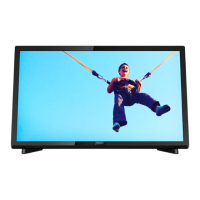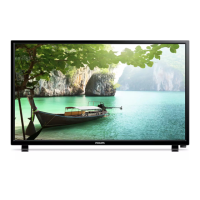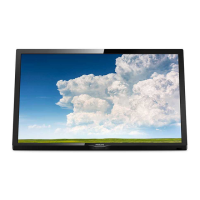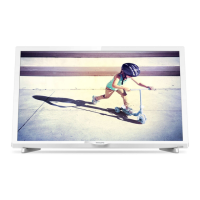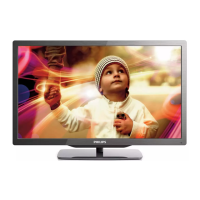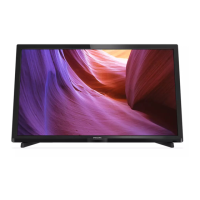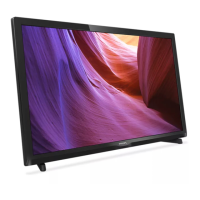
Do you have a question about the Philips 22PFH4000 and is the answer not in the manual?
| Screen shape | Flat |
|---|---|
| Response time | - ms |
| Display diagonal | 22 \ |
| Display brightness | 200 cd/m² |
| Display technology | LED |
| Native aspect ratio | 16:9 |
| Native refresh rate | 60 Hz |
| LED backlighting type | - |
| Supported video modes | 1080p |
| Display diagonal (metric) | 56 cm |
| Screen format adjustments | 4:3, 16:9 |
| Supported graphics resolutions | 1920 x 1080 (HD 1080) |
| Motion interpolation technology | PMR (Perfect Motion Rate) 100 Hz |
| 3D | No |
| Refurbished grade | Grade A |
| Annual energy consumption | 35 kWh |
| DVI-D ports quantity | 0 |
| USB 2.0 ports quantity | 1 |
| Consumer Electronics Control (CEC) | EasyLink |
| Tuner type | Analog & digital |
| Analog signal format system | NTSC, PAL, SECAM |
| Digital signal format system | DVB-C, DVB-T |
| RMS rated power | 5 W |
| Power consumption (standby) | 0.3 W |
| Power consumption (typical) | 24 W |
| Operating temperature (T-T) | 5 - 35 °C |
| Product color | Black |
| Panel mounting interface | 75 x 75 mm |
| Audio formats supported | AAC, MP3, WAV, WMA |
| Image formats supported | BMP, GIF, JPG, PNG |
| Video formats supported | AVC, AVI, MKV, MPEG1, MPEG2, MPEG4, VC-1, WMV9 |
| Subtitle formats supported | AAS, SMI, SRT, SSA, SUB, TXT |
| Package depth | 100 mm |
| Package width | 600 mm |
| Package height | 390 mm |
| Package weight | 3500 g |
| Cables included | AC |
| Depth (with stand) | 112 mm |
|---|---|
| Height (with stand) | 317 mm |
| Weight (with stand) | 2700 g |
| Depth (without stand) | 35 mm |
| Width (without stand) | 512 mm |
| Height (without stand) | 308 mm |
| Weight (without stand) | 2600 g |
Learn how to pause and record TV broadcasts using a USB hard drive.
Understand how EasyLink enables control of connected devices with the TV remote.
Read important safety guidelines before operating the television.
Instructions for installing the TV stand or mounting it on a wall.
Tips for positioning the TV for best viewing and ventilation.
Proper steps for connecting the TV's power cable.
How to connect an antenna cable for TV signal reception.
General advice on using quality cables and the Philips connectivity guide.
How EasyLink uses HDMI CEC to manage connected devices.
Guide for installing a Common Interface (CAM) module for conditional access.
Instructions for connecting a set-top box (digital receiver) to the TV.
Steps to connect a satellite receiver to the TV.
How to connect a Home Theatre System via HDMI or SCART.
Configuring audio output and troubleshooting HTS sound problems.
Connecting a Blu-ray disc player using HDMI or SCART.
Connecting a DVD player via HDMI or SCART.
Connecting a game console using HDMI for optimal performance.
Requirements for using a USB hard drive for pause and record features.
Viewing photos, music, and videos from a USB flash drive.
Connecting a camcorder to the TV using an HDMI cable.
Connecting a computer to use the TV as a monitor.
Connecting headphones and adjusting their volume separately.
How to turn the TV on, put it into standby, and switch it off.
Explanation of the functions of different buttons on the TV remote control.
Understanding the IR sensor and replacing remote control batteries.
Proper methods for cleaning the TV remote control.
How to switch channels and navigate the channel list.
Setting up parental ratings and child lock codes for content restriction.
Adjusting the picture format to fit the screen and hide black bars.
Accessing and navigating Teletext pages for information.
Customizing Teletext display, language, and features.
Managing subtitles and audio languages for digital and analogue channels.
Manually enabling subtitles for analogue channels via Teletext.
Choosing preferred primary and secondary audio languages for programmes.
Changing the TV menu and message display language.
Configuring the TV for automatic updates of new channels.
Reinstalling channels, full TV installations, and factory reset.
Procedures for copying and uploading channel lists using a USB device.
Setting up DVB-T or DVB-C reception and changing antenna connections.
Navigating to DVB-C settings for manual configuration.
Adjusting symbol rate mode and values for DVB-C channel installation.
Network frequency, scan methods, digital/analogue setup, and manual installation.
Navigating and viewing programme information, changing days, and searching by genre.
Receiving guide data, scheduling recordings, and watching recorded programmes.
Accessing the Sources menu to switch between connected devices.
Turning on connected devices like disc players or HTS from TV standby.
Using EasyLink for convenient control of HDMI CEC-compatible devices.
Setting the TV to automatically switch to standby after a specified time.
Correcting the TV's clock time and daylight saving settings.
Managing the automatic power-off feature to save energy.
Connecting USB devices and navigating through photos, music, and videos.
Settings for slideshows, transitions, and image display.
Controls for music playback, including repeat, shuffle, and file info.
Settings for video playback, including subtitles, audio, and file info.
How to pause and resume live TV broadcasts on digital channels.
Using instant replay and the progress bar for paused broadcasts.
Necessary components and setup for recording TV programmes.
Steps to record a programme as it is being watched.
Setting up future recordings using the TV guide.
How to access and play back recorded TV programmes.
Selecting and adjusting picture styles for optimal viewing.
Fine-tuning picture parameters like contrast, colour, and sharpness.
Utilizing MPEG reduction, Digital Crystal Clear, Gamma, Tint, Video Contrast, and Brightness.
Selecting sound styles, adjusting Bass, Treble, and other sound parameters.
Managing surround sound, headphones, auto volume, speaker output, clear sound, and HDMI ARC.
Configuring audio output levels, delay, and offset for external systems.
Controlling TV speaker output and routing sound to external devices.
Adjusting settings based on TV placement (stand or wall mount).
Choosing Ambilight modes (Dynamic, Static) and setting static colours.
Adjusting the brightness and saturation levels of the Ambilight.
Setting Ambilight response speed and compensating for wall colour.
Configuring how Ambilight behaves when the TV is turned off.
Information on eco settings, energy saving, and power management.
Understanding the energy label and end-of-use disposal guidelines.
Technical details on reception for PxH/PxT models.
Screen sizes, resolutions, and computer format compatibility.
Details of rear and side connections for Pxx4000 and PxH4000/PxT4000 models.
Speaker output power and sound enhancement features.
Information on supported file types and USB connection limits.
Steps to update the TV's software using a USB memory device.
How to view the current TV software version.
Information about open-source software included in the TV.
The legal statement regarding open-source software licenses.
Listing of various open-source libraries like zlib, libdirectfb, libTomMath, MTD, OpenSSL, libboost, libjpeg.
Information about the FFMpeg software component.
Solutions for problems finding digital channels or missing installed channels.
Troubleshooting power issues, creaking sounds, and remote control unresponsiveness.
Diagnosing and fixing issues like no picture, distorted images, or poor reception.
Resolving problems with no sound, poor audio quality, EasyLink, and USB media playback.
Benefits of registering the TV and how to do it online.
How to use the TV's built-in help system.
Finding solutions and support through Philips' online resources.
Contacting customer support for repairs and service information.
Important safety instructions, preventing tipping, electrical hazards, injury, and overheating risks.
Advice on handling the TV in extreme temperatures, humidity, and during lightning storms.
Proper methods for cleaning the TV screen and avoiding damage from stationary images.
Legal terms, warranty conditions, and pixel characteristic information.
Information on HDMI and Dolby copyrights and licensing.
Details on MHEG software copyright, Kensington, and other trademarks.



